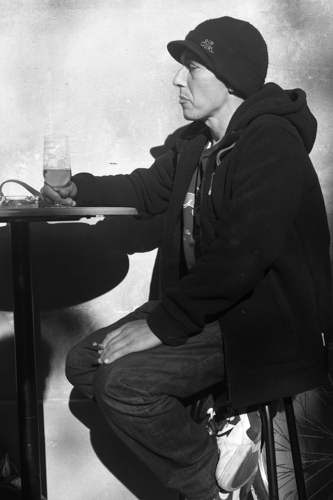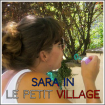Quick Look: Voigtländer 28mm/1.9 Ultron with the Fuji X-Pro 1
Most street scenes worth photographing happen only a couple of meters in front of you. At that distance the X-Pro1 AF really can not keep pace with the movement of the subject, at least not with the 35mm/1.4. To be fair the X-Pro 1 is not alone in this as the subject’s speed of movement across the frame at short distances is tough for most cameras to keep up with.

X-Pro1/35mm1.4: Just not quick enough, both focus and timing were off
For this situation zone focusing is the order of the day. While this technique is possible with all the Fuji lenses, there remains the issue of shutter lag. Thankfully, with the aid of an adapter, one can use third party lenses. This not only removes the lag but opens up a whole world of possibilities from high quality glass from your favorite vendor, to the more funky creative options like lensbabies. There is a whole range of adapters available for various mounts from third party vendors (see cameraquest), but Fuji themselves only support the Leica M mount adapter.
The Voigtländer Ultron F1.9
The Ultron is a very good leica screw mount lens. On a the Leica M8.2 I found it to be sharp in the center of the frame from F2.8 and, as one would expect, there is some fall off in light and resolution at the corners at larger apertures. Unfortunately I have not found it to be particularly sharp at F1.9, anywhere in the frame. The Ultron has two distinctive features: it is quite low contrast, so images tend to look flatter than they would with a more modern design, and it is not coated. The latter makes for some nasty veiling flair in high contrast or direct light situations, further reducing contrast. Low contrast is not necessarily a bad thing as it can allow for some latitude in post processing, but for this review I want to concentrate on out of the camera jpgs.
The X-Pro 1 has a fantastic jpeg engine which allows one to control various aspects of contrast and saturation. So it offers the possibility to address the flat look in camera. Veiling flair, as in all lenses has to be used or controlled by the photographer.
I had high hopes that this lens could be close to the ideal for street shooting with the X-Pro1.
The Challenge
The Ultron 28mm/1.9 was designed for film, not digital sensors and certainly not the Fuji X-Trans sensor. The lack of micro lenses on Fuji’s new sensor means that light rays from older lenses will hit the edge and corners of the sensor at too oblique an angle resulting in loss of resolution, light fall off and potential colour shifts due to diffraction. This predominantly affects symmetrical, and some pancake type lenses. Fuji have built their own XR lenses with this in mind and effectively compensate for the lack of micro lenses in their design. No such luck for the Voigtländer Ultron, however it is not a symmetrical design so it should perform better than some of its siblings.
So does this Ultron/X-Pro1 live up to its promise, or are there more irks than quirks.
Shutter lag: It is gone and the camera is much more reactive as a consequence.
Manual focusing: For this review I did not use the Optical viewfinder at all as naturally you need to use the EVF to focus manually with this lens. Without magnification this can be tricky as there is no focus indicator of any sort. However there seems to be a visible shimmer on items that are in focus. I don’t know if this is by design, as I can find no reference to it in Fuji’s documentation. The 3x/10x magnifier, available via a push of the thumb wheel, is useful but even a 28mm lens needs steady hands at 10x to enable really accurate focusing. If you are picky, you should open the lens right up to ensure critical focus and then stop down to your intended shooting aperture. Good luck with that while shooting on the street. With the Ultron 28mm/1.9, I found it very difficult to focus wide open and I had to stop down to F2.8 to make this work satisfactorily. Overall this is quite a slow process and, for me at least, is not anywhere close to ideal for street work.
Manual focusing with the X-Pro 1 is not in the rangefinder class, but it works as designed. It just could be designed a bit better.
As I said before one can default to zone focusing. Sadly, when this lens is coupled to the Fuji M adapter the focus distance marker on the lens is no longer accurate. This is due to the adapter not maintaining the right register distance so that lenses can focus on infinity properly. Fuji do warn this may happen with some lenses, but it does make zone focusing a tad more problematic than it should be. As an example, if you are focusing on a object 1.2m away, set the focus distance to 1m, for 2m its 1.5 and for 3m use 2m. Now before you start to holler that there is always a level of inaccuracy in focusing distance, let me just say that the same lens on my M8.2 works as one would expect, i.e. if the object is 1.2m away, set the focus distance to 1.2m.
Ok so this can be worked around for zone focusing – but it is yet another irk to live with.
Image quality:
Apt market on a Saturday mornings is a riot of colour and contrasty light so I thought it might through up interesting opportunities to see how the combination works. All shots were taken with the camera set to Astia, DR =100, and colour, shadow tone and highlight tone set to standard. I also left the lens meni settings at their standard configuration. Although I shot raw+jpg all the images here are out of camera jpgs produced using the in camera raw conversion, with any post work other than WB noted in the captions.

No major issue with light fall off or colour shift (F8, Astia, Curve adjust in LR)
Not a very artistic shot but the above does show that there is not a major issue with vignetting or colour shifts at the edges/corners. Overall however the image has much more contrast and vibrancy than I expected, based on my experience using this lens on the Leica M8.2. Clearly the Fuji jpeg engine is producing the goods here. The images also seems to have a sort of soft glow, which I quite like for portraits, such as the beer drinker below, but no so much on the shot above. Tweaking the clarity slider in LR can deal with this if you so desire.
Corner resolution does however suffer as shown below, with the railings on the windows rendered with some ugly artifacts. Edge resolution however is ok. Notice also the cyan edge on the paper on the ground below the sheep. As to whether these things matter in practice is up to the reader to decide. For most of my work they would not be a major issue.

Center + left corner – 100% screen grab

Center + right edge – 100% screen grab
I have become accustomed to using a -1/3 — – 2/3 EV adjustment when shooting with the Fuji 35mm/1.4 to compensate for some overexposure. Using this with the Ultron however seemed to lead to blocked up shadows, and over saturated colours. But then I see and think in black and white so my colour sense may not be that great

selling clothes – apt market. (F8, Astia, BW conversion in LR)

Checking the label. A single small widow provided the only light in this restaurant. (F2, ISO2500, Astia, BW conversion in LR)

Lost in thought (Astia, BW conversion in LR)
The X-Pro1 has a third party lens menu (lens mount adapter settings menu) to allow the photographer to compensate for light fall off, colour shifts and lens distortion when it does occur. Cleverly this is accessible via a button on the adapter – Nice touch. For this review I just used 28mm at the standard settings, to see how things went. However there is a potentially neat feature in this menu. The menu has predefined options for 21,24,28 and 35mm lenses. It also allows for two custom lenses to be defined, and it alters the position of the frame lines in the optical view finder to approximate the FOV. So in theory through trial and error one could use this to create the ideal frame lines for a given focus distance/focal length for correct framing with the OVF. I have not tried it, but it should work.
Final words.
When shooting candid shots the camera just has to get out of the way, you don’t want any distractions or delays. The Ultron combined with the X-Pro1 almost achieves that goal. There is no shutter lag and framing is easy through the EVF. An inaccurate focus distance however is a major distraction, and it took me most of the morning to start to get to grips with it. I am sure if I were to stick at it then it would become second nature. If my other M mount lenses would all behave slightly differently in this regard it would make working with this adapter a big distraction.
The image quality however I think is quite fine for this type of work, and the look is quite different to the Fuji glass. I think it is a combination that is worth continuing to experiment with.
As for manual focusing….lets face it the X-Pro1 is really a AF camera. Lets hope the new range of Fuji lenses perform better in the AF department.
If you like this post, stay up to date by following me on Twitter: Follow @wideanglecafe
Related Posts
Taming the Shrew: Experiences using the Fujinon Xf-60mm
A walk on the wide side : Using the Fujinon 14mm




Pingback: Quick Look: Voigtländer 28mm/1.9 Ultron with the Fuji X-Pro 1 | X-Pro 1 by Fuji | Scoop.it
Excellent assessment.
Although I have found that the distance markers on the pile of various lenses I use are anything but accurate, it is fun nonetheless to go out and focus on the fly with my shutter finger ready at the half-press. Once I see critical focus is achieved, Bob’s your uncle. The absence of any shutter/meter/processing lag with manual glass is refreshing, but one still has to contend with the slight lag in the EVF.
Your results are great. It grows on you a bit, doesn’t it?
Thanks Denis. While we all crave the end result, the process and experience of producing a good image is just as important to me. The x-pro1 with manual glass is right up there in that regard and like all tools it takes practice for everything to become second nature.
Overall I really like the look of the images from this lens.
Thanks for commenting.
Hi George,
Truer words never spoken. It’s a wonderful process and one that is becoming more and more rare as camera technology makes autofocus, ISO, shutter speed and aperture selection afterthoughts for the most part. Your images speak for themselves the people shots display a wonderful sense of timing and perspective.
My latest toy is a $34.00 55mm/1.7 Minolta MC that I’ve had on the shelf for months but have shied away from as I’m not comfortable shooting at that focal length. Finally buckled down and left the other glass at home, what a brilliant lens. I imagine it’s probably time to share some of those images.
Cool, I will keep an eye on your blog for them. Happy shooting and thanks for the compliments
Pingback: Quick Look: Voigtländer 28mm/1.9 Ultron with the Fuji X-Pro 1 | George | Fuji X-Pro1 | Scoop.it
Dear George. You’re hunting on the same place as I am: the Luberon also with an X-Pro1… recognizing a lot in what you are doing. Apt’s market is indeed a very wonderful place to make images, so colorful, still retaining quite some of that old ‘south of france’ charm. Look at f.i. the pictures Willy Ronis (one of the most famous ‘Provence’ photographers ever) at the same place. Regarding the X-Pro1, I’m using mostly Fuji-lenses, also an old Russian M42 Helios lens (55mm) providing a magnificent bokeh and in wide open, a kind of soft focus towards the edges, difficult to describe. That’s what a like about the X-Pro1: a magnificent sensor with a very film alike rendition, you can link to any (even very old) lens you want.
Hi Dirk,perhaps we have met. I bumped into a belgian guy with an x-pro1 in Apt market around the end of October.
Love the work of W.Ronis.
I agree part of the attraction of the x-pro1 is its versatility and the ability to use all sorts of glass.
Thanks for taking the time to comment.
Yes… I remember our meeting. Next time, we’ll sit down for a drink 😉 .
Pingback: Quick Look: Voigtländer 28mm/1.9 Ultron with the Fuji X-Pro 1 | Everything about Fuji X-Pro1 and Fuji X-E1 | Scoop.it
Pingback: X-Roundup | Fuji Rumors
Dear George,
Your findings no surprise! I have seen many lenses designed for film and all need one or 2 stops down. The Zeiss biogon design lenses have all less impressive corner resolution & sharpness.
You may check on this interesting publication:
http://www.ebay.com/itm/251199251288?ssPageName=STRK:MESELX:IT&_trksid=p3984.m1555.l2649
Also the Leica summicrons cannot compete with the corner’s results of the new Fujifilm lenses
Regards,
Jan vogelaar
Pingback: Quick Look: Voigtländer 28mm/1.9 Ultron with the Fuji X-Pro 1 | Everything about Fuji X-Pro1 and Fuji X-E1 | Scoop.it
> A single small widow provided the only light in this restaurant…
She must have been carrying a torch for someone. 8=)
LOL never spotted the typo, thanks
You’re welcome. It reminded me of Gerard Hoffnung’s letters from Tyrolean landlords (3’35” in, on here — https://www.youtube.com/watch?v=sq-q6TcbHLE ).
Pingback: Focus Peaking Part 1: Fuji Xpro1 and Voigtländer 35mm f2.5 Color Skopar | The Wideangle Cafe